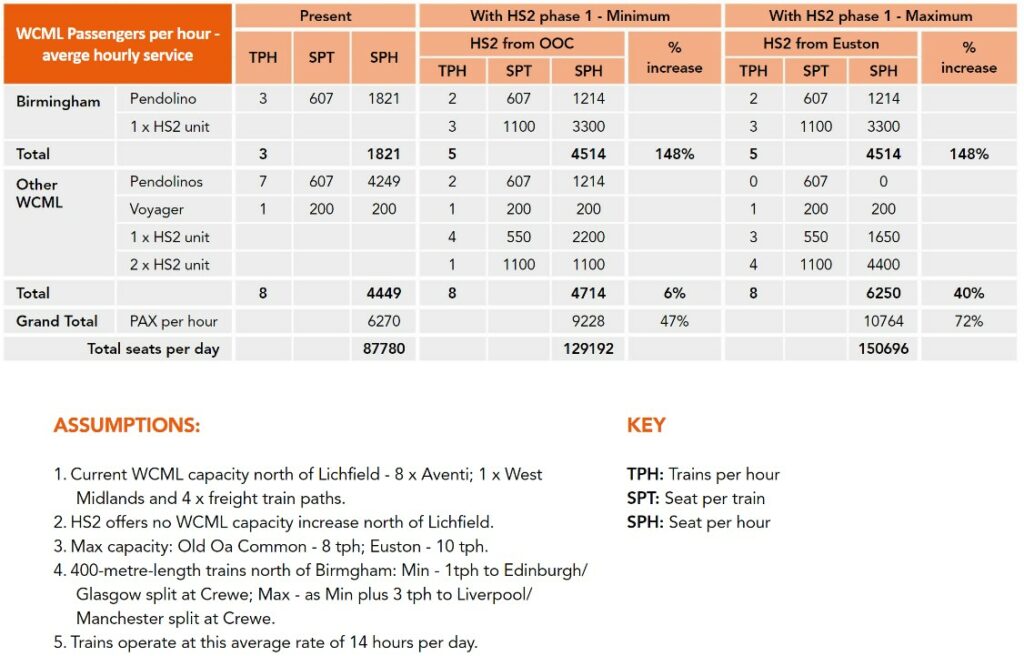In the Parliamentary debate on the cancellation of HS2 phase 2, Transport Minister Mark Harper claimed that what remains of HS2 will deliver “a massive increase in capacity to the West Coast Main Line (WCML)” by providing 250,000 seats a day. This figure was subsequently repeated by the Prime Minister and Rail Minister who advised that it applies “across the primary long-distance operator on the West Coast.”
Yet without HS2 phase 2a, there is to be no WCML capacity increase north of Lichfield. Furthermore, with no HS2 station in Manchester it will not be possible to run the planned two-unit 400-metre HS2 trains to the city. Instead, there can only be single 200-metre unit HS2 trains which are shorter than the current 265-metre Pendolino trains.
Furthermore, 250,000 seats a day is equivalent to running 17 x 605-seat Pendolinos an hour, 24 hours a day. This is clearly not credible.
Estimating WCML HS2 capacity
The table below estimates minimum and maximum capacity increases from HS2 phase 1. It shows a massive capacity increase between London and Birmingham with little benefit north of Birmingham unless all HS2 Manchester trains have a Liverpool portion and stop to split at Crewe. For many reasons, including an additional 10-minute journey time, this is a far from ideal arrangement.
Shadow Transport Minister Stephen Morgan has twice asked Rail Minister Huw Merriman to provide the evidential basis for the claimed 250,000 seats per day for HS2 phase 1. In neither case did he receive an answer. Since November, your writer has also unsuccessfully been trying to obtain the basis for these figures by pursing various stages of a Freedom of Information (FOI) request.
After the DfT press desk refused to provide this information, I submitted an FOI request in December. In January I was advised that more time was needed to consider my request as “a complex public interest test needs to be carried out to determine whether the information should be disclosed.”

It was considered that my request was subject to FOI Act clause 35 (1) which enables requests to be refused if the information requested relates to policy in development (i.e. the HS2 timetable) as disclosing it would detract from the time and space required by ministers and officials to develop policy options. The public interest of giving ministers such space must be balanced against that of letting the public understand how the capacity numbers were derived.
Public interest test
In February, my FOI request was refused on the basis that the public interest is best served by not divulging this information. Yet, although it is perfectly reasonable to keep possible policy options confidential until they have been announced, my request was not for policy options (i.e. possible HS2 timetables) but for the baseline capacity information needed to derive such timetables.
For this reason, I requested an internal review of this decision and also referred to FOI clause 35(2) which states that once government has decided a policy, any statistical information used to provide an informed background is no longer subject to FOI clause 35(1). Hence, the 250,000 seats a day figure used to justify the cancellation of HS2 should be exempt from clause 35(1).
On 22 March, I received a four-page letter explaining why it was not in the public interest to divulge the information I requested. Amongst other things, this letter advised that the 250,000 seats a day figure was not considered to be statistical information mentioned in clause 35(2) as “some of the information underpinning the assumptions and calculations used to derive the seat capacity is derived from comparable assumptions, estimates, and other judgements and opinions rather than being traceable back to factual data.”
This seems to substantiate my view that 250,000 seats a day was a guess. As shown by the table on the previous page, this is not a complex calculation.
FOI clause 35 is a dry subject, and so it is to be hoped that this explanation of its niceties has not been too dull. Yet this is an important subject as government transparency is in the public interest. Hence, anyone who wishes should be able to find out how figures used to justify polices have been derived. The public should also have confidence that the data used to develop policies is not uninformed assumptions.
Lead image credit: Avanti West Coast

